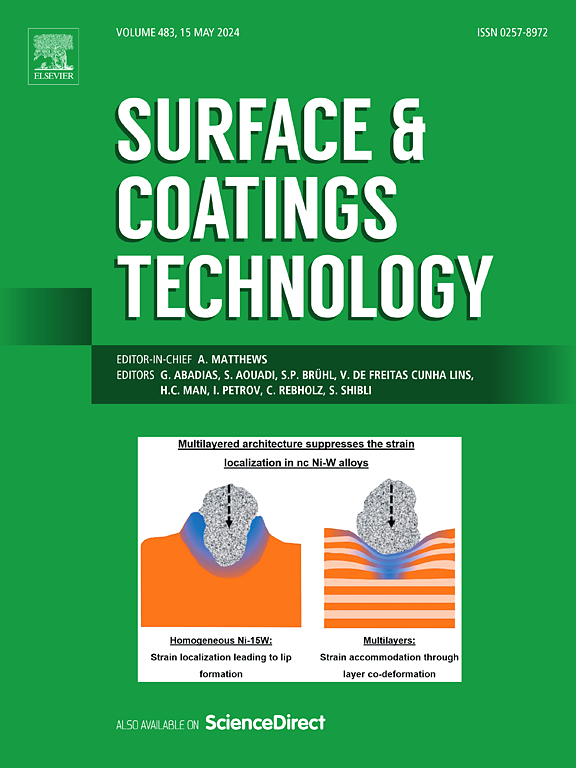Laser processed bionic super-slippery surfaces toward the electricity generation through low-adhesion sliding of magnetofluid achieving corrosion resistance of marine metals
IF 5.3
2区 材料科学
Q1 MATERIALS SCIENCE, COATINGS & FILMS
引用次数: 0
Abstract
Marine engineering facilities are perpetually exposed to the harsh corrosive conditions of high salinity and humidity, where traditional corrosion resistance technologies often grapple with the challenge of limited energy supply. This study innovatively integrates bionic super-slippery surface technology with magnetofluid power generation to develop a novel self-powered corrosion resistance system. By employing laser texture processing to construct hierarchical microstructures on metal substrates and infusing them with lubricating fluids, a super-slippery surface with a contact angle exceeding 150° and a sliding angle below 3° was successfully fabricated. This surface demonstrates exceptional magnetofluid repulsion properties, significantly reducing residual liquid retention compared to conventional surfaces, thereby effectively addressing the energy loss issues caused by solid/liquid adhesion in traditional magnetofluid power generation. When applied to marine buoy corrosion resistance, the super-slippery surface leverages its low-adhesion to harness wave motion, driving continuous magnetofluid power generation to supply a stable current for cathodic protection systems. The generated current maintains the metal surface at a lower potential, reducing the corrosion rate by over 50 %. This research not only pioneers a new application pathway for super-slippery surfaces in the energy sector but also offers an innovative solution for marine energy exploitation and the protection of metal materials in marine environments.

激光加工仿生超滑表面,利用磁流体的低粘附滑动发电,实现海洋金属的耐腐蚀
海洋工程设施长期暴露在高盐度和高湿度的恶劣腐蚀条件下,传统的耐腐蚀技术往往面临能源供应有限的挑战。本研究创新性地将仿生超滑表面技术与磁流体发电技术相结合,开发了一种新型的自供电耐腐蚀系统。利用激光织构技术在金属基体上构建层次化微结构,并注入润滑液,成功制备了接触角超过150°、滑动角小于3°的超光滑表面。该表面具有优异的磁流体斥力特性,与传统表面相比,显著减少了剩余液体潴留,从而有效地解决了传统磁流体发电中由固/液粘附引起的能量损失问题。当应用于海洋浮标耐腐蚀时,超滑表面利用其低粘附性来驾驭波浪运动,驱动连续磁流体发电,为阴极保护系统提供稳定的电流。产生的电流使金属表面保持在较低的电位,使腐蚀速率降低50%以上。这项研究不仅为能源领域的超滑表面开辟了新的应用途径,而且为海洋能源开发和海洋环境中金属材料的保护提供了创新的解决方案。
本文章由计算机程序翻译,如有差异,请以英文原文为准。
求助全文
约1分钟内获得全文
求助全文
来源期刊

Surface & Coatings Technology
工程技术-材料科学:膜
CiteScore
10.00
自引率
11.10%
发文量
921
审稿时长
19 days
期刊介绍:
Surface and Coatings Technology is an international archival journal publishing scientific papers on significant developments in surface and interface engineering to modify and improve the surface properties of materials for protection in demanding contact conditions or aggressive environments, or for enhanced functional performance. Contributions range from original scientific articles concerned with fundamental and applied aspects of research or direct applications of metallic, inorganic, organic and composite coatings, to invited reviews of current technology in specific areas. Papers submitted to this journal are expected to be in line with the following aspects in processes, and properties/performance:
A. Processes: Physical and chemical vapour deposition techniques, thermal and plasma spraying, surface modification by directed energy techniques such as ion, electron and laser beams, thermo-chemical treatment, wet chemical and electrochemical processes such as plating, sol-gel coating, anodization, plasma electrolytic oxidation, etc., but excluding painting.
B. Properties/performance: friction performance, wear resistance (e.g., abrasion, erosion, fretting, etc), corrosion and oxidation resistance, thermal protection, diffusion resistance, hydrophilicity/hydrophobicity, and properties relevant to smart materials behaviour and enhanced multifunctional performance for environmental, energy and medical applications, but excluding device aspects.
 求助内容:
求助内容: 应助结果提醒方式:
应助结果提醒方式:


